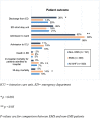The emergency department arrival mode and its relations to ED management and 30-day mortality in acute heart failure: an ancillary analysis from the EURODEM study
- PMID: 35164693
- PMCID: PMC8842939
- DOI: 10.1186/s12873-022-00574-z
The emergency department arrival mode and its relations to ED management and 30-day mortality in acute heart failure: an ancillary analysis from the EURODEM study
Abstract
Background: Acute heart failure patients are often encountered in emergency departments (ED) from 11% to 57% using emergency medical services (EMS). Our aim was to evaluate the association of EMS use with acute heart failure patients' ED management and short-term outcomes.
Methods: This was a sub-analysis of a European EURODEM study. Data on patients presenting with dyspnoea were collected prospectively from European EDs. Patients with ED diagnosis of acute heart failure were categorized into two groups: those using EMS and those self-presenting (non- EMS). The independent association between EMS use and 30-day mortality was evaluated with logistic regression.
Results: Of the 500 acute heart failure patients, with information about the arrival mode to the ED, 309 (61.8%) arrived by EMS. These patients were older (median age 80 vs. 75 years, p < 0.001), more often female (56.4% vs. 42.1%, p = 0.002) and had more dementia (18.7% vs. 7.2%, p < 0.001). On admission, EMS patients had more often confusion (14.2% vs. 2.1%, p < 0.001) and higher respiratory rate (24/min vs. 21/min, p = 0.014; respiratory rate > 30/min in 17.1% patients vs. 7.5%, p = 0.005). The only difference in ED management appeared in the use of ventilatory support: 78.3% of EMS patients vs. 67.5% of non- EMS patients received supplementary oxygen (p = 0.007), and non-invasive ventilation was administered to 12.5% of EMS patients vs. 4.2% non- EMS patients (p = 0.002). EMS patients were more often hospitalized (82.4% vs. 65.9%, p < 0.001), had higher in-hospital mortality (8.7% vs. 3.1%, p = 0.014) and 30-day mortality (14.3% vs. 4.9%, p < 0.001). The use of EMS was an independent predictor of 30-day mortality (OR = 2.54, 95% CI 1.11-5.81, p = 0.027).
Conclusion: Most acute heart failure patients arrive at ED by EMS. These patients suffer from more severe respiratory distress and receive more often ventilatory support. EMS use is an independent predictor of 30-day mortality.
Keywords: Acute heart failure; Arrival mode; Emergency medical services; Management; Prognosis; Ventilatory support.
© 2022. The Author(s).
Conflict of interest statement
The authors declare that they have no competing interests.




